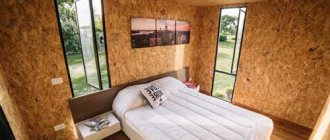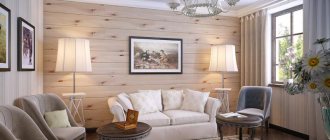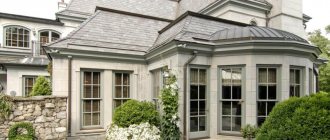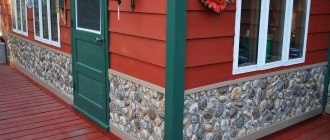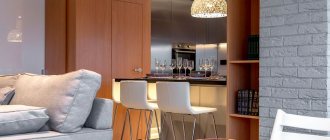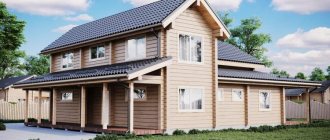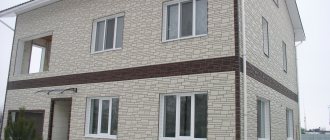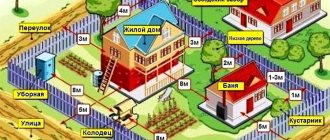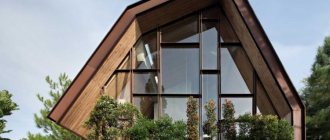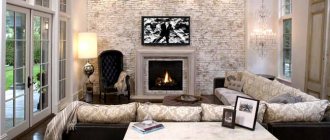More and more people are thinking about the environmental friendliness of their homes, so decorating the inside of the house with wood is gaining mass popularity. Indeed, this solution can be considered one of the best. It should be borne in mind that the material has many excellent qualities, but is also not without some significant disadvantages. Working with wood is not always easy, but the results are worth it.
Lining
- wide selection of shades and textures;
- sound insulation and thermal insulation;
- environmental Safety;
- pleasant appearance;
- basic installation.
- pay attention to the wooden lining
- it is this that brings tangible notes of unique home comfort into the atmosphere and exudes a characteristic pleasant aroma; - the specification of the material should be marked “for interior decoration”
- an important point, since some types of wooden lining are intended exclusively for facade work; - find out the type of wood used before purchasing
- such information is always relevant, since different types of wood behave differently in conditions of high humidity, focus on lining options made of linden, alder, oak if you are planning finishing in a bathroom, bathhouse or kitchen; - The so-called eurolining is also on sale
- this finishing material has improved characteristics, is well ventilated and is practically not subject to swelling even in conditions of constant high humidity, it is more expensive, but it has an impressive appearance and an impressive long service life.
- a frame is assembled from metal profiles or wooden slats;
- sheets of lining are attached to it with clamps or, in the old fashioned way, with nails.
And in this article you can familiarize yourself with step-by-step instructions for installing lining.
Features of the interior decoration of an old wooden house
If a house made of timber or logs has stood for several decades, first of all you need to assess the condition of the wood. To do this, remove all the trim and “pick” at all suspicious spots - darker or lighter in color, different in structure or texture. This can be done with a screwdriver, chisel, even a knife. If the wood is dense throughout, there are no signs of destruction, everything is fine, you can begin finishing. You may need to first impregnate walls and other structures with a protective impregnation to protect the wood for several more decades. But not all owners of wooden houses agree to chemical treatment, so it’s up to you to decide.
If the wood crumbles due to your efforts, you need specialist advice. It is necessary to determine what caused the damage - insects, fungi or microorganisms - and what measures need to be taken. Then the damaged pieces or elements are replaced, paying special attention to treating the adjacent areas with antiseptics and protective impregnations.
After assessing or “treating” the wood, you can begin to update its appearance. The interior decoration of an old wooden house is no different from those described above. The only reason is that shrinkage is not worth taking into account: there is no longer any significant progress. So from this side everything is somewhat simpler.
Drywall
- helps hide utility lines;
- allows you to achieve a perfectly flat wall surface;
- absorbs moisture well;
- possibility of non-linear editing.
You should also be careful when purchasing drywall in a store. You should start from the characteristics of the room in which the cladding is planned. If you have to deal with a permanently damp place, it is best to choose moisture-resistant gypsum board sheets
.
They are usually available in blue or green. For rooms with high temperatures and a certain risk of fire, pink
drywall is suitable - it has a reliable fire-resistant coating that will help protect your walls from unpleasant surprises.
One of the advantages of covering walls with plasterboard in a wooden house is that it is easy to install.
Thanks to the dimensional sheets, the cladding can be completed quite quickly. True, you will first have to build a sheathing
- this is an improvised frame made of metal profiles or wooden beams. It can successfully hide all sewer and ventilation communications, cables that spoil the appearance of the room. After the gypsum board sheets have been attached, all that remains is to treat them with a primer, seal all the seams with serpyanka, thoroughly putty all the defects and paint or whitewash them in the color that fits into the format of your interior.
An important point that I would like to pay close attention to: new wooden houses tend to shrink after some time, so it is recommended to cover them with plasterboard only after this.
In this case, it is necessary to leave 1-2 cm
at the junction with the floor and ceiling, since wooden walls tend to swell - and one day the cladding may simply tear. Video with recommendations from experts.
Wooden wall panels: types and features
This section of our online store is dedicated to practical wood panels that will decorate any home interior. Their cost is already a reason not to put off renovating your apartment for a long, long time, but, without worrying about your budget, start doing it. We will also tell you about Meister 3D wall panels made in Germany, their features and positive aspects. We will also try to clearly show you how decorating your walls with these panels that will be discussed will change the atmosphere in your home for the better.
Cork
- 100% environmentally friendly;
- excellent sound insulation;
- magnificent relief;
- solid and expensive look.
This is the case when the obvious visual advantages of a cork correlate with its technical characteristics and the numbers on the price tag. This option is certainly suitable for a respectably furnished wooden house, in which a lot of money has been invested. If you plan to cover the walls inexpensively, then you can use a little trick - use cork to decorate individual wall fragments. In this case, the costs will not be so high - and nothing will interfere with the pleasure of contemplating the spectacular wall cladding in the house.
It is better to glue cork to a wall in a wooden house using special contact glue. It grips the sheet perfectly even with low consumption. Of course, before this it is necessary to prepare the surface of the wall itself:
- remove irregularities;
- clean from dust and debris;
- remove any remaining old material.
It is best to thoroughly level the walls before doing this, but if you don’t really want to do this with plaster, then gypsum board sheets will be an excellent and, most importantly, inexpensive alternative.
Decorative rock
- creates a beautiful natural look;
- favorably emphasizes the relief of noble stones;
- undergoes final finishing.
One of the advantages of using decorative stone for interior wall cladding in a wooden house is the low cost of the base material. As a rule, this is gypsum, but there are also options combined with cement. The latter, as a rule, are a little heavier, but in any case much more convenient for cladding than “wild” stone.
The only downside is the increased demands of this cladding material on the wall surface. It must be perfectly smooth, otherwise the created relief will not be so expressive. In order to cover the walls with decorative stone, it is best to use tile adhesive or liquid nails. The first option is recommended if the cladding material is made on the basis of a weighted mixture of gypsum and cement, the second - for cladding based on lightweight gypsum that is convenient for cladding.
Plastic
- attractive appearance;
- modest cost;
- excellent moisture resistance;
- unpretentious care.
People's love for plastic is as imperishable as their love for wood. What if it turns out to be correctly combined in one room?
Due to its good moisture resistance, plastic can be successfully used for inexpensive and reliable interior decoration of walls in the bathroom, toilets and kitchen in a wooden house. In order to properly frame the walls, you will have to build the usual frame - such sheathing will allow you to achieve a perfectly flat surface.
If previously the choice of plastic for wall coverings was quite modest, now you can choose sheets with a wide variety of textures and colors. There are also beautiful relief models, which in some rooms of your house can fit perfectly into the simulated interior.
Types of wood used in production
Different types of wood are distinguished not only by their texture pattern and shade, but also by their performance characteristics, which significantly affect the price of future products. Before purchasing wooden panels, it is necessary to understand the characteristics of the material that will affect its further operation.
The following tree species are used in the production of decorative wall coverings:
- Birch. The material has an average degree of hardness and bending strength, as well as a high level of viscosity and elasticity of the fibers. These features prevent the wood from splitting easily and quickly. Birch is practically not susceptible to mold and mildew, since it has antiseptic properties. The material may be light pink or yellowish.
- Beech. Wood is characterized by high strength and heavy weight, but at the same time it responds well to bending. Due to its high hygroscopicity, the material is processed using a special technology using moisture-resistant compounds so that it does not crack or warp. When cut, beech can be red-brown, red-pink or pale beige.
- Cherry. This valuable wood is of high quality and decorative. Cherry has good elasticity and can be easily processed , but due to its low strength and weak resistance to external factors, it is used only for interior decoration. Wood without a pronounced texture comes in a variety of shades: these are either nuances of white, or rich tones of burgundy and brown.
- Walnut. One of the valuable types of wood, used in the manufacture of various coatings. Walnut has high density, hardness, toughness and bending strength. It is characterized by a variety of colors, fine fibers and a high degree of moisture resistance. The material lends itself well to processing and varnishing.
- Oak. The high physical and aesthetic characteristics of wood are known to everyone. It is characterized by large mass, high density and attractive texture. Other characteristics depend on the specific type of oak, which can have any shade, as well as varying degrees of elasticity and strength.
- Maple. Light yellow or white wood has almost all the same characteristics as oak. Maple is characterized by high flexibility, strength and wear resistance, which makes the material practical.
- Larch. The textured pattern features smooth color transitions. Usually the material has a light pink tint. Larch has an interesting property: if it is exposed to moisture for a long time, it will become stronger. It is also worth noting its high density and fire resistance.
- Pine. This breed is a cheap option that is available to any consumer. Typically, pine has a yellowish or ocher tint with red-brown splashes. Medium density wood has good resistance to fungus. It is easy to process and does not pose any difficulties during installation.
- Ash. The material is characterized by a beautiful heterogeneous pattern with light stripes of different widths. It has an average density. A light variety of wood is used to decorate dark rooms.
All breeds differ from each other in properties that determine the cost of the future product. In addition, wooden panels can have a protective coating against chemical and mechanical influences, which further increases the price. But higher quality finishes can be used in various rooms.
Ceramic tile
- reliable and inexpensive;
- suitable option for bathrooms and toilets;
- complex installation.
Another good answer to the question of how you can inexpensively and beautifully cover the walls of your home, if it is made of wood. Good - in terms of material costs and the final decorative effect. However, in order to lay the tiles evenly and correctly, you cannot do without special skills. Still, good specialists are worth it.
The tiles are glued to the base surface using tile adhesive, and after direct cladding, the seams are sealed with fugue - a special grout that prevents the appearance of pathogenic flora on the walls of a wooden house and, at the same time, by adding various dyes, also helps to emphasize certain shades in the interior.
Options for finishing materials by structure
Few people can purchase solid wall panels. But if you want to finish with natural wood, you can use composite materials based on it. Their price is lower than for products made from solid pieces of wood.
The following materials are in great demand:
- MDF. Panels made from fine particles have an average density. Lamination or veneering is applied to the front surface of the boards, imitating natural wood.
- Chipboard. Particle boards are a relatively inexpensive material that comes in the form of panels of various shapes and sizes. The external decorative coating imitates the real structure of wood .
- Fiberboard. Fiberboards are used to produce sheet panels, which can be with or without a decorative coating. In the second case, additional finishing is required after installing the products on the walls.
- OSB. Wood chips are used to make oriented strand boards or sheets. Usually the material is installed under a different finish. In the case of using OSB as a base, after installation, painting is applied to the surface.
Although composite materials imitate real wood as closely as possible, they all have one drawback. In the manufacturing process of wall panels, formaldehyde resins are used, due to which the products lose their environmental friendliness. Many manufacturers try to reduce this disadvantage to a minimum, but natural wood will always outperform its cheap alternatives in terms of quality.

